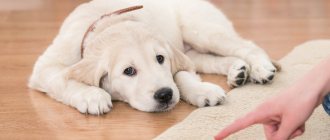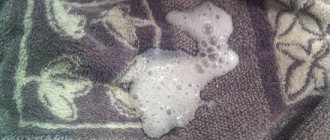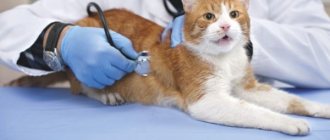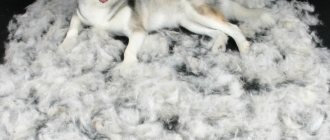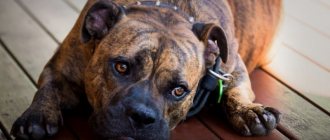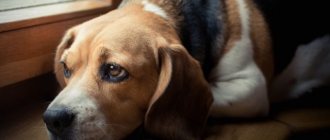How does the dog's urinary system work?
The urinary system is responsible for removing waste from the blood through urine (urine), and also maintains acidity and electrolyte balance. It consists of:
- The kidney is a bean-shaped organ responsible for filtering blood. Its main part is the nephrons, which screen out waste products of the body from the plasma, form urine, sending it to the ureter through the calyces and the renal pelvis.
- The ureters are tubes through which urine from the kidneys enters the bladder using peristalsis (wave-like muscle contractions).
- The bladder is a bag for temporary storage of urine. As it fills with urine, it stretches and at a certain stage begins to irritate the nerve endings. The brain receives a signal and orders it to empty.
What happens next is:
- The valves (sphincter muscles) that prevent urine from spontaneously flowing out of the bladder relax.
- The detrusor, the muscle layer inside the bladder, contracts.
- Urine, under the influence of the detrusor, opens the valves and flows out through the urethra (urethra). In females it is shorter, in males it is longer.
Small puppies are unable to control the process of urination, but as they grow and are raised, they learn to hold urine and urinate in the right place. This happens due to muscle tension, including the pelvic floor.
Main symptoms of urinary incontinence in dogs
If the pet couldn’t bear it and left a puddle, this is not a problem, and it’s too early to talk about incontinence. You need to be wary when such a phenomenon as “dripping” urine appears, the dog’s genitals turn red, and she diligently licks them. There are wet spots on the animal's bedding; it is damp and stinks.
Other symptoms of incontinence:
- increased frequency of urination;
- pain during bowel movements;
- lethargy;
- weight loss;
- thirst;
- change in appetite.
Red urine and vomiting are warning signs that require an urgent visit to the doctor.
How does urinary incontinence manifest?
Symptoms may manifest as constant leakage of urine or partial leakage due to sphincter insufficiency. In this case, spots often appear in clearly inappropriate places, such as on a bed or on a pet’s sleeping place. The dog's behavior usually does not change (for example, during sleep). Often, the animal tries to stop the involuntary release of urine by licking the genitals (in this case, rashes appear on the skin and hair disappears).
Pathological or true incontinence is also manifested by nocturia (frequent urination); soreness (as evidenced by the dog whining) and discharge in small portions.
Functional incontinence should be differentiated from true incontinence (revenge of an animal on its owner, or the desire to thus define boundaries in the house).
Causes of involuntary urination in dogs
Urinary incontinence can affect any pet. At risk are spayed middle-aged and older females. Pathology occurs due to weakening of the sphincter, as well as stones in the bladder or urethra. Having determined the causes of urinary incontinence in an old dog, treatment must be strictly adhered to. You will probably need pet diapers.
Other causes of urinary incontinence in dogs that require treatment:
- bladder inflammation or infection (cystitis);
- weak detrusor;
- sterilization;
- spinal injury (degeneration);
- stress;
- kidney disease;
- spinal cord abnormalities;
- congenital pathologies;
- prostate diseases;
- diabetes mellitus and other conditions that cause increased thirst and metabolic disorders.
Congenital pathologies
The most common birth defect that causes involuntary urination is ectopic ureter, when it bypasses the bladder and connects to the urethra. Due to the absence of a valve here that holds back urine, liquid will drip even from young animals.
The problem is most often encountered by huskies. Also prone to pathology:
- miniature poodle;
- Labrador Retriever;
- collie;
- Welsh Corgi;
- Wire Fox Terrier;
- West Highland White Terrier.
The pathology is more often recorded in females. If the anomaly is only in one ureter, the pet will excrete urine drop by drop, almost imperceptibly, and urinate normally. If the structure of the two ureters is incorrect, urine will only drip, and the animal will not be able to empty itself normally.
To determine the causes of urinary incontinence in a young dog and treatment, consult a doctor. If the diagnosis shows ectopic ureter, the only solution to the problem is surgery.
Urinary tract infections
The most common problem that owners of bitches face is cystitis, caused by a bacterial infection. Pathology often develops due to hypothermia. The disease can be transmitted sexually during mating or swimming in a dirty pond. Bitches are more likely to experience cystitis due to their shorter urethra than that of males. If a young or old dog has urinary incontinence, treatment should be prescribed by a doctor.
Antibiotics are prescribed for cystitis. If the pathology is not treated, the bladder may become scarred, causing it to lose its elasticity and ability to stretch normally. The disease will become chronic, and you will have to walk the animal often.
Prostate in males
The cause of urinary incontinence in a dog can be prostatitis - inflammation of the prostate gland. Its increase impairs the flow of urine, interferes with normal emptying, causes a weak stream, frequent urination or leakage. This problem of urinary incontinence in an old dog is usually fixed. Antibiotics are prescribed for treatment.
Sterilization
The symptom is observed in sterilized pets of both sexes, and blood and urine tests are normal. Incontinence can last from several months until the end of the animal's life.
There are several explanations:
- Hormonal disorders - estrogen deficiency in females, testosterone in males.
- A poorly performed operation.
- Changes in the length of the urethra, which leads to its displacement and worsening of valve closure. Presumably, as the dog ages, the problem with urination increases.
Urolithiasis disease
The cause of urinary incontinence in an old dog is stones. They are formed from various types of salts in the kidneys or bladder. The formations may not make themselves felt until they block the passage or reach a large size. Incontinence can occur if a stone gets stuck in the valve area and prevents it from closing. If the formation completely blocks urine output, the animal may die within a few days.
If a young or old dog has urinary incontinence, what to do is consult a veterinarian. Previously, stones were treated only surgically and a diet was prescribed. Now there are technologies that can crush formations without serious surgical intervention. The method of treating urinary incontinence in a dog will depend on the doctor and the technical capabilities of his clinic.
Nervous system problems
The functioning of the urethra is controlled by the brain, sending a signal along nerve fibers that are woven into the spinal cord. If these tissues are affected, incontinence may occur. For the same reason, a pet does not hold urine if there is a spinal injury.
The symptom is accompanied by muscle weakness, complete or partial paralysis is possible.
Fear
The dog involuntarily urinates, fearing to upset the owner. She can wait for him all day without any problems, and as soon as she sees him, she will have a bowel movement while waiting for him to go for a walk.
The problem often arises due to improper toilet training, when the puppy was shouted at or hit for puddles. The first thing to do if a dog has urinary incontinence due to fear of punishment is to establish the most trusting contact so that the animal is not afraid of the owner. You may need the help of an animal psychologist.
Difficulty urinating in dogs: how to identify the disease and help the animal
Common Clinical Causes of Difficulty, Frequency, and Painful Urination in Dogs
In veterinary medicine, symptoms of urinary incontinence in animals are classified as urological pathogenesis (disease). Dysfunction in the functioning of the urinary ducts directly depends on the healthy or painful state of the organs included in the branched genitourinary system - the kidneys, bladder, urethra, and cervical canal.
The causes of pathogenic processes in these organic structures are two factors:
Infectious and inflammatory etiology. Based on the introduction of harmful pathomicroflora (microbes, bacteria, viruses, parasitic microorganisms) into the mucous surfaces of these organs. Usually these are acute forms of urethritis, cystitis, and ureaplasmosis.
Inflammatory processes that arose as consequences of chronic diseases of non-infectious origin. Urological diagnoses such as urolithiasis, accumulation of sand in the urinary ducts and kidneys, nephropathy and nephritis (kidney disease).
In both the first and second cases, urination in dogs is accompanied by pain, frequent urges and strained, difficult flow of urine.
It is impossible to identify the root cause of a dog’s urological malaise at home. To do this, it is necessary to conduct a laboratory examination of the pet: take a smear from the urethra, cervical canal, and examine the urine. You also need to examine the dog’s internal organs using special equipment: an endoscope (a thin catheter with a built-in mini-camera at the end). The veterinarian, moving a thin wire with a visualizer at the end through the dog’s urinary system, sees a projection on the computer monitor - the internal cavity of the bladder, ducts, and ureters.
Information from laboratory and hardware examinations of the dog allows the veterinarian to accurately establish a diagnosis and prescribe appropriate, correct and professional treatment. The doctor will prescribe medications that are aimed specifically at the main causative agent of the infection. Or he will prescribe conservative therapy to cure a urological, chronic disease. It is possible that your pet will have to be treated with intravenous or intramuscular injections. Of course, such manipulations should only be done in a veterinary hospital, by experienced veterinary specialists.
Useful and important information for dog owners
Where and from where can a dog become infected, for example, with infectious viral microflora? On a walk, in dog parks. Some dogs like to lie on the grass, snow, and crawl on their bellies in the sand. The feces of sick dogs (with a viral infection) that have walked here before easily penetrate into the external areas of the genitourinary organs of other dogs.
Kidney disease, urolithiasis occurs due to improper feeding/drinking. The water needs to settle before pouring it into the dog’s bowl. Especially if you use city water supply. It is better to give melt water to a dog with diseased kidneys. In the evening, scrape the “frost” from the freezer into a bowl, and before the morning a healing and clean drink for the dog will be ready.
Before making an appointment with a veterinarian, the dog's owner can relieve the dog's painful spasms. Place between the hind legs, closer to the stomach, a diaper made of flannel, heated with a warm iron. If the dog is an indoor breed, you can bring it to the veterinary hospital (wrapped in a blanket). It is more difficult with large breed dogs. If the disease has just begun, keep your pet on a leash. Under circumstances of an advanced stage, a threatening epicrisis in a dog, call a doctor at home or take it by transport to a veterinary clinic.
To cure diseases of the genitourinary system in a dog in a timely manner and as early as possible means that you are guaranteed not to have such phenomena as difficult, frequent and painful urination in your pet.
To help your animal, make an appointment at the “Your Doctor” veterinary clinic by phone.
From 10 to 21 o'clock any day of the week we are ready to accept you and your pet!
Diagnosis and treatment of urinary disorders in dogs
Contact a good clinic to find out the causes of urinary incontinence, treatment, medications. The doctor will make a diagnosis based on urine, blood, ultrasound, and x-ray tests. An MRI may be needed, but veterinary clinics rarely provide this option. We must look for exits to the human laboratory.
Depending on the disease, your veterinarian will determine how to treat your dog's urinary incontinence. There are three options for treating the problem:
- Conservative – the doctor prescribes antibiotics, anti-inflammatory, hormonal drugs, and recommends a diet.
- Surgical – used for abnormalities in the structure of the urinary system or the presence of stones.
- Radical – euthanasia, when the owner does not want to treat the animal.
To prevent your pet from dirtying the floor, furniture, and bedding, buy diapers. Important: buy pads taking into account not only the size, but also the gender of the animal. The cut of diapers for females and males is different.
The dog urinates involuntarily: reasons and what to do?
Urinary incontinence (incontinence) occurs in dogs of any age. The owners of the animal make a rash decision, even to the point of wanting to euthanize it.
I will tell you about the possible causes of involuntary urination and what you need to do in each case.
If the diagnosis is made correctly and treatment is started in a timely manner, the chances of a full recovery are high.
Incontinence can be true or forced (imaginary). In the first case, the dog involuntarily urinates due to a disorder of innervation, which is a congenital deformity, a consequence of injury, or senile weakening of reflexes. In sterilized dogs, the hormonal status changes, so the same conditions occur as in older pets.
Imaginary incontinence develops as a symptom of an underlying disease. In both situations, the warning sign disappears if the cause is eliminated.
Natural
True incontinence is characterized by constant leakage of urine. The animal secretes urine drop by drop while moving or resting. The owner notices puddles at the site of the pet's rookery.
The following causes of incontinence are considered natural:
- Stressful . Arises as a result of fear or joy. A faithful dog perceives the visiting owner as the leader of the pack. Urination is a sign of complete submission.
- Uncleanliness . The dog was not trained or it was done unprofessionally. Often a dog leaves marks in inappropriate places to attract the attention of an owner who is indifferent to him. Some dogs consider themselves the dominant animal and mark the territory of the apartment out of spite. Sometimes being unclean is a cry for help. The dog signals that he is sick and needs to be taken to the veterinarian.
- Marking the territory . This is not a pathology, but a norm. Adult animals place scent marks during periods of increased sexual activity. The female signals to the male that she is ready to mate. The male warns the rival not to enter his territory. Males prefer to spray urine on vertical surfaces - posts, corners, etc.
This is my territory
Diseases
The following causes of urinary incontinence are considered pathological:
- Spinal injuries . Infringements occur and innervation is disrupted.
- Relaxation of the sphincters of the urinary reservoir and urethra . Elderly dogs suffer, in which the pathology developed as a complication of chronic diseases. The disease also occurs at an earlier age. The sphincter relaxes and does not hold urine in obese dogs, mainly females. In castrated animals, pathology develops three years or later after sterilization.
- Ectopia is a congenital defect. The ureters open directly into the urethra, bypassing the reservoir. There is no sphincter, so urine is released in drops. Ectopia is characterized by the presence of concomitant inflammatory diseases of the genital organs.
- Cystitis is inflammation of the bladder. The pathology is provoked by microflora that has penetrated the genital tract due to weakened immunity. Bitches get sick more often than males, due to the proximity of the urethral opening to the anus. In addition to urinary incontinence, inflammation of the bladder, you will find the following symptoms:
- whining during bowel movements;
- urine becomes cloudy and smells foul;
- the pet feels nauseous, tosses and turns, and cannot find a comfortable position;
- loss of appetite.
demonstrative defecation anywhere;
The development of the disease is facilitated by improper maintenance and unbalanced nutrition. If you notice the above symptoms, seek veterinary help. Acute cystitis is well treated and ends in recovery without complications. A chronic disease requires lifelong treatment.
- males do not lift their paws, but sit down;
bitches vigorously lick their genitals;
Sometimes urolithiasis occurs as a result of untreated cystitis. Other reasons are nutritional imbalance in protein. A high percentage of low quality protein contributes to an increase in the concentration of uric salts and precipitation. Neutered animals are predisposed.
Complete cessation of urination is an ominous sign. Stones block the ureter, urine stops being released. The animal falls into a coma and dies.
- Pyometra is a purulent inflammation of the uterus. The disease develops in females with reduced immunity after abnormal whelping or as a result of genital infections. Additional signs include a painful, bloated abdomen. If there is no vaginal discharge, this is bad. Pus accumulates in the uterine cavity. The disease is life-threatening.
Preventing urinary incontinence in pets
To prevent urinary incontinence, follow these recommendations:
- Don't keep your dog in the cold. If she lives outside, take her home during frosts. Make a warm enclosure.
- Do not allow your pet to lie on a draft or cold floor.
- Walk regularly, if possible - 3 times a day. Preferably at least an hour.
- Do not prevent your pet from urinating frequently outside. An empty bladder will leak less, and it will be easier for the dog to wait for a walk.
- Keep the house clean and wash her bedding regularly. It will be more difficult for bacteria to penetrate the animal's urinary system.
- Do not punish your dog for puddling, otherwise the problem may worsen or appear.
- Monitor the animal's weight.
- Don't give food from the table.
Treat urinary tract diseases in a timely manner. If the dog behaves suspiciously, take its temperature; it should not exceed 38.5 degrees. Contact your veterinarian immediately with any concerns.
If dogs have urinary incontinence, buy medications for treatment only at a certified pharmacy, for example, Gomeovet. Products purchased in ordinary veterinary stores, and even more so at the market, may turn out to be fake. In an attempt to make money, scammers counterfeit not only expensive but also cheap drugs. Therefore, it is not worth the risk.
